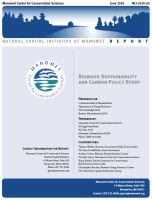
Study of wood energy C balance released
June 15, 2010
By Manomet
 |

|
June 15, 2010, Plymouth, MA – The Massachusetts Department of Energy Resources (DOER)
and Manomet Center for Conservation Sciences (Manomet) have released the
results of a six-month study that began last December to answer some critical
questions about using forest wood for energy in Massachusetts. An eight-member
team of policy and science experts from several organizations conducted the
Manomet-led study, commissioned by DOER in fall 2009.
Some of
the major questions addressed by the study include: (1) How much wood is
available from forestland for biomass energy in Massachusetts? (2) What might
be the impacts of increased biomass harvests on forest ecosystems? (3) What
are the carbon accounting implications of using forest biomass for energy?
Many U.S.
states and countries around the world are promoting and investing in forest
biomass energy because using wood for energy is commonly assumed to be carbon
neutral and therefore good for mitigating climate change. The Manomet study,
which is based on a comprehensive life-cycle carbon accounting framework,
reveals a more complex picture. The study shows that using wood for energy can
result in an initial carbon debt because burning wood releases more CO2 into
the atmosphere per unit of energy than fossil fuels (oil, coal, or natural
gas). But unlike fossil fuels, forests can grow back and recapture CO2 from the
atmosphere. Over time, through accelerated forest growth, the carbon debt can
be paid off. After the carbon debt is paid off, if the forest continues to
grow, a carbon dividend is realized, and the use of wood for energy then
becomes increasingly beneficial for greenhouse gas mitigation. As a result,
using wood for energy can lead to lower atmospheric greenhouse gas levels than
fossil fuels, but only after the point in time when the carbon debt is paid
off. Whether or not full carbon neutrality will be achieved in these
circumstances depends on if, when, and how the forest is harvested in the future.
The most
innovative and policy-relevant finding in the report is the
“debt-then-dividend” model, which shows that using forest biomass for energy
can increase greenhouse gases for a period of time before it reduces them. The
length of time it takes to pay off the carbon debt and begin accruing carbon
dividends (i.e., greenhouse gas benefits) can vary widely, from five years to
decades. The length of time depends on a complex interaction of the type of
biomass energy used (electricity, heat, or combined heat and electricity), the
fossil fuel that biomass energy replaces (coal, oil, or natural gas), and the
degree the growth potential of the forest is realized by the landowners' forest
management methods.
As an
example, with an electric power plant that relies on biomass using whole trees
from natural forests in the Massachusetts region—and not waste wood from tree
work and landscaping that has different carbon cycle effects—the carbon debt
period is likely to last for at least 20 or 30 years before carbon benefits
begin to be realized. In contrast, using forest biomass in thermal applications
such as heating municipal buildings or schools has lower carbon debts and can
provide carbon dividends for the atmosphere sooner, generally within 10 to 20
years.
The study
also examined woody biomass energy policies from other states, federal
agencies, and international agencies, which might help inform Massachusetts’
policy. The team modeled forest growth rates and examined the economics of
supplying forest biomass for energy. At current electricity prices, biomass for
electricity generation will remain a low-value product, with prices ($1 to $2 per
green ton) that will not motivate forest landowners to increase harvest levels
very much. However, the value of wood as a heating fuel is much higher.
Increased development of small-scale thermal applications could provide
landowners with greater financial incentives to harvest biomass.
Thomas
Walker, the study team leader, says, “Understanding the greenhouse gas impacts
of woody biomass energy is extremely complex. We’ve come up with a
comprehensive but relatively straightforward framework and methodology that can
help policy makers in Massachusetts, or anywhere, better understand if and when
any particular wood biomass energy scenario might be climate friendly. Forests
in other geographic areas can be evaluated similarly, but will yield
context-specific results with respect to greenhouse gas costs and benefits.”
Manomet
president Dr. John Hagan adds, “Our interest is in getting the best, unbiased
information in the hands of policy makers and the public so they can draw their
own well-informed conclusions about whether woody biomass energy makes sense.
The team has cleared away a lot of the former confusion about wood energy.” Hagan
says that although the study was conducted for Massachusetts, the team’s carbon
accounting approach has worldwide relevance for informing biomass energy
policies. “Massachusetts deserves a lot of credit for getting answers to some
critical questions about biomass energy that people have been asking all around
the world.”
The executive summary and full report can be downloaded from the Manomet web site:
www.manomet.org/node/322.
The Manomet study team members are:
Thomas Walker, Team Leader – Independent Resource Economist
Dr. Peter Cardellichio – Independent Forest Economist
Andrea Colnes – Biomass Energy Resource Center
Dr. John Gunn – Manomet Center for Conservation Sciences
Brian Kittler – Pinchot Institute for Conservation
Bob Perschel – Forest Guild
Christopher Recchia – Biomass Energy Resource Center
Dr. David Saah – Spatial Informatics Group
Print this page